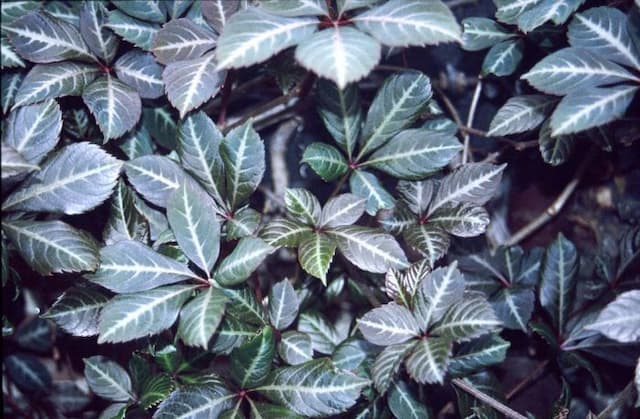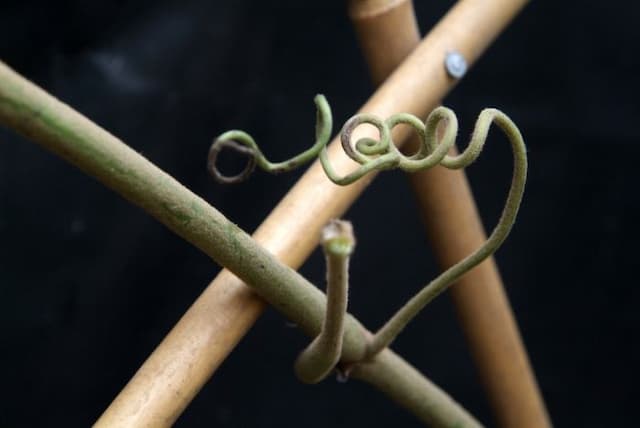Muscat Bleu Grape Vitis 'Muscat Bleu' (O/b)

ABOUT
The plant known as 'Muscat Bleu' is a variety of grape that is cherished for its attractive and productive nature. The foliage of Muscat Bleu is typically lush green with broad leaves that provide a beautiful backdrop for the fruit. The leaves may display a slight toothed edging and are known for their dense, overlapping arrangement on the vine, which can create a thick canopy. The grapes themselves are the standout feature of this plant and are the reason for its popularity. They are typically small to medium-sized and grow in clusters that hang from the vine. As suggested by the name 'Muscat Bleu,' the grapes boast a deep blue to nearly black hue when ripe, often with a characteristic waxy bloom on the surface that can give them a subtle, frosted appearance. The skin of the grapes is relatively thin but protective, and the flesh inside is juicy with a high sugar content, which makes them delightful for fresh eating. The aroma of the grapes is pleasantly fragrant, and they are known for their sweet, musky flavor profile that is reminiscent of the classic Muscat grapes. This aromatic quality often lends itself to an enjoyable eating experience and can also contribute to delightful wines when the grapes are fermented. Throughout the growing season, Muscat Bleu can produce abundant bunches of these delicious grapes, which not only provide a treat for the senses but also add an ornamental aspect to the garden or vineyard with their striking color and inviting presence. The contrast between the vibrant green foliage and the deep blue grapes makes Muscat Bleu a visually appealing plant that can enhance the aesthetic of any space where it is grown.
About this plant
 Names
NamesFamily
Vitaceae.
Synonyms
Muscat Bleu Grape, Blue Muscat Grape.
Common names
Vitis 'Muscat Bleu'
 Toxicity
ToxicityTo humans
The common name for Vitis 'Muscat Bleu' is grapevine, specifically a cultivar of grape. Generally, the cultivated grapevine fruit is not toxic to humans when consumed in normal food quantities. However, other parts of the grape plant, such as the leaves and stems, may cause stomach upset if ingested in large amounts due to tannins and other compounds. The grape seeds also contain small quantities of compounds that can be toxic in extremely high doses, but they are unlikely to cause harm when consumed as part of the normal diet.
To pets
The common name for Vitis 'Muscat Bleu' is grapevine. It is important to note that grapes and raisins (dried grapes) can be highly toxic to dogs and cats. Ingestion can lead to sudden kidney failure in pets. The symptoms of grape or raisin poisoning in pets may include vomiting, diarrhea, lethargy, abdominal pain, loss of appetite, and signs of kidney failure such as decreased urination. Even a small amount of grapes or raisins can be dangerous to pets, so it is crucial to avoid feeding them any part of the grape plant and seek veterinary care immediately if accidental ingestion occurs.
 Characteristics
CharacteristicsLife cycle
Perennials
Foliage type
Deciduous
Color of leaves
Green
Flower color
Greenish-white
Height
4-6 feet (1.2-1.8 meters)
Spread
3-5 feet (0.9-1.5 meters)
Plant type
Climber
Hardiness zones
5
Native area
Europe
Benefits
 General Benefits
General Benefits- Attractive Foliage: The leaves of the 'Muscat Bleu' grapevine provide an aesthetic quality to gardens with their lush green appearance.
- Edible Fruits: This variety produces sweet, edible grapes that can be eaten fresh or used for making wine, jellies, and juices.
- Shade Provider: Vines like 'Muscat Bleu' can be grown over pergolas or arbors, offering pleasant shade in sunny outdoor areas.
- Wildlife Attraction: The grapes attract birds and other wildlife, which can be beneficial for biodiversity.
- Easy Propagation: 'Muscat Bleu' can be easily propagated from cuttings, making it relatively simple for gardeners to expand their vineyards or share with others.
- Year-Round Interest: Throughout the seasons, the vine provides visual interest from budding leaves in spring to fall foliage and winter vine structure.
- Screening Plant: The dense growth habit of grapevines can be used as a natural screen for privacy or to hide unsightly areas.
- Cultivation Versatility: 'Muscat Bleu' is adaptable to a variety of soil types and can be grown in containers or open ground, making it versatile for different garden designs.
 Medical Properties
Medical PropertiesThis plant is not used for medical purposes.
 Air-purifying Qualities
Air-purifying QualitiesThis plant is not specifically known for air purifying qualities.
 Other Uses
Other Uses- The vine of grape can be trained to grow over pergolas and arbors, providing a leafy green canopy during the summer months and a source of shade for outdoor seating areas.
- Grape leaves can be used in culinary applications, as they are edible and can be stuffed with a variety of fillings to make dishes like dolmas.
- The sturdy vines and woody parts of old grape plants can be repurposed into rustic crafts or used as natural supports for other climbing plants in the garden.
- Grape plants can be utilized as a natural dye source, where the skins and leaves provide varying shades of yellow, green, or purple to textiles and materials.
- The dried tendrils and leaves of grape vines make excellent additions to compost bins, contributing to a rich and fertile compost for garden use.
- When pruned, the flexible young canes of grape vines can be woven into baskets, wreaths, or other decorative items.
- After harvesting grapes, the empty clusters can be dipped in suet or peanut butter and rolled in birdseed to create a bird feeder.
- The thick foliage of grape vines can be used as a natural screen for privacy or to hide unsightly areas in the garden.
- In some educational demonstrations, grape vines are used to teach principles of pruning and vine management for both agricultural and home gardening purposes.
- During the fall, grape vines offer aesthetic value to the garden with their foliage that turns vibrant shades of red and yellow, adding to the seasonal display of colors.
Interesting Facts
 Feng Shui
Feng ShuiThe grapevine is not used in Feng Shui practice.
 Zodiac Sign Compitability
Zodiac Sign CompitabilityThe grapevine is not used in astrology practice.
 Plant Symbolism
Plant Symbolism- Fertility: Grapevines like 'Muscat Bleu' have often been associated with fertility and abundance due to their lush growth and abundant fruit production.
- Vitality: The vigor with which grapevines grow symbolizes vitality and the life force.
- Prosperity: Grapes have been a sign of prosperity, particularly in cultures where vineyards are a sign of wealth or a successful harvest.
- Transformation: From grape to wine, this plant symbolizes transformation and change, often associated with spiritual and personal growth.
- Celebration: Wine made from grapes, including 'Muscat Bleu', is often used in celebrations, making the grapevine a symbol of joy and festivity.
 Water
WaterGrapevines like 'Muscat Bleu' require deep watering to encourage strong root development, especially during their growing season. Initially, after planting, water the grapevine about once a week with about 1-2 gallons, allowing the soil to dry out slightly between waterings. As the vine establishes itself, you can reduce the frequency but ensure you provide enough water to penetrate 6-8 inches into the soil. During hot, dry periods, you may need to water more frequently. However, during the dormant season, you should cut back on watering significantly to prevent root rot.
 Light
Light'Muscat Bleu' grapevines perform best in full sun, which means they should receive at least six hours of direct sunlight a day. The ideal spot for planting is an area where the vines are exposed to plenty of sunlight throughout the day, ensuring good fruit set and ripening. Lack of sufficient sunlight can lead to poor fruit development and increased susceptibility to diseases.
 Temperature
TemperatureGrapevines including 'Muscat Bleu' are hardy in a range of temperatures but prefer a temperate climate. The ideal temperature for healthy growth and fruit production ranges from 75 to 85 degrees Fahrenheit during the growing season. They can survive temperatures down to about 20 degrees Fahrenheit during dormancy. It's important to protect vines from frost, especially during the budding and flowering stages which can be damaged by temperatures below 32 degrees Fahrenheit.
 Pruning
PruningPruning is essential for 'Muscat Bleu' grapevines to maintain plant size, shape, and to encourage fruit production. Prune in late winter or early spring before new growth begins when the plant is still dormant. Remove dead or diseased wood, thin out crowded areas to improve air circulation, and cut back each vine to leave only a few buds to ensure a good yield. This should be done annually to promote healthy plants and abundant fruit.
 Cleaning
CleaningAs needed
 Soil
SoilThe Muscat Bleu grape vine thrives in well-draining soil with a mix of loam and compost, with a pH range of 5.5 to 6.5 for optimal growth.
 Repotting
RepottingMuscat Bleu grape vines, when grown in containers, should be repotted every 2-3 years to ensure sufficient room for root growth and nutrient availability.
 Humidity & Misting
Humidity & MistingMuscat Bleu grape vines do well in moderate humidity levels; they do not require high humidity environments as typical for many houseplants.
 Suitable locations
Suitable locationsIndoor
Ensure strong light, prune to manage size, and support with a trellis.
Outdoor
Full sun, trellis for support, protect from strong winds, winter hardy.
Hardiness zone
5-9 USDA
 Life cycle
Life cycleVitis 'Muscat Bleu', commonly known as the Muscat Bleu grape, begins its life cycle as a dormant vine with buds that swell and burst open in spring, marking the vegetative stage. Leaves and shoots develop rapidly, and following this, the flowering stage occurs, typically in early summer, where small, greenish-white flowers appear and pollination takes place, ideally resulting in fruit set. The grapes undergo berry growth throughout the summer, with the ripening stage being characterized by a change in color and sugar accumulation, leading to mature grapes by late summer or early fall. Harvesting of the Muscat Bleu grapes usually occurs when the fruits reach optimal sweetness, often determined by taste or sugar measurements. After harvesting, the plant enters senescence in autumn, where leaves change color and fall, and the vine moves into a period of dormancy during the winter months, conserving energy for the next growing season. The cycle repeats yearly with careful pruning during dormancy to ensure plant health and productivity.
 Propogation
PropogationPropogation time
Late winter-early spring
The most popular method of propagating the 'Muscat Bleu' grapevine is through hardwood cuttings. This technique involves taking mature, dormant cuttings from the existing grapevine during the late fall or winter months. The cuttings should be about 12 to 18 inches (30 to 45 cm) in length with several buds on them. They are then buried in damp sand or soil, or placed in a cold frame until early spring to allow roots to start developing. Once the risk of frost has passed and the cuttings have rooted, they can be transplanted into their permanent location. This method is favored for its simplicity and high success rate, allowing gardeners to clone their favorite grapevines efficiently.









